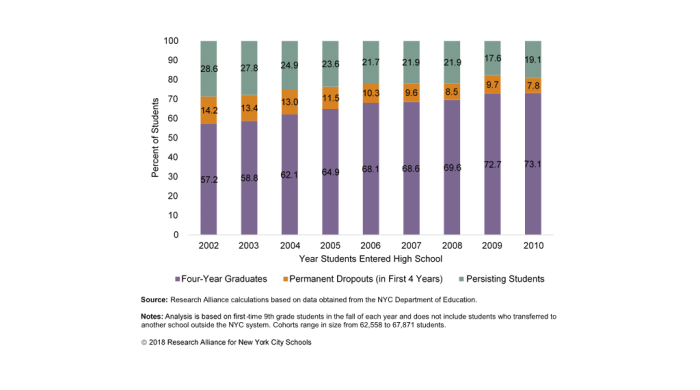Analysis of four-year graduation rates of English learners shows influence of individual characteristics.

Michael Kieffer, Associate Professor of Literacy Education
English learners are, on average, less likely to graduate high school in four years than students who never needed to learn English in school. But social identities like race and gender make a difference, and some groups of English learners are actually more likely to graduate, according to a new study by a team of education researchers at NYU Steinhardt and the University of Houston.
For instance, young women who ever learned English in school are more likely to graduate in four years than young men who did not. Similarly, Black English learners tend to have better four-year graduation rates than Black peers who never needed to learn English in school.
"Language learning doesn’t happen in a vacuum, so students – both those who are currently learning English and students who have already become fluent in the language – have a whole host of social factors that influence their school trajectories in ways that might be really different from students who never had to learn English in school,” says Michael Kieffer, an associate professor of literacy education at NYU Steinhardt School of Culture, Education, and Human Development and the senior author of the study, which appears in the journal Educational Researcher.
Benjamin Le, Sociology of Education PhD Student
“This study highlights the very diverse outcomes of students who learn English in school and shows that this group is not a monolith,” says Benjamin Le, a doctoral student at NYU Steinhardt and the lead author of the study. “We see that English learner classification does matter for high school graduation, but more importantly, the extent that it matters depends on other social identities of the student.”
Le, Kieffer, and their co-authors analyzed data for 127,931 New York City high school students who began ninth grade in 2013 and 2014 to see whether students graduated on time, defined as graduating within four years. Their data included race/ethnicity, gender, socioeconomic status, and English learner status. They classified English learners based on whether students had ever received federally mandated language services to become proficient in English (“ever-ELs”) and compared them with students who never had to learn English in school (“never-ELs”).
Overall, their findings showed that never-ELs were four percent more likely to graduate within four years than ever-ELs, consistent with previous research. However, comparing English learner status with the added variable of gender revealed different outcomes: ever-EL young women were four percent more likely to graduate than never-EL young men. In addition, Black students were the only racial/ethnic group for which English learners were more likely to graduate in four years. Latine English learners were found to be the least likely to graduate in four years, and Asian/Pacific Islander ever-ELs were substantially more likely to graduate than Latine and Black students, regardless of the latter groups’ English learner status.
Differences in graduation between ever-ELs and never-ELs also depended on socioeconomic status. Ever-ELs in low-income neighborhoods (where the median household income was below $40,000) were equally likely to graduate compared to never-ELs in similar neighborhoods. But in middle- and high-income neighborhoods with household incomes above $40,000, ever-ELs were less likely to graduate than never-ELs in similar neighborhoods.
The study was supported by a grant (R305C200016) from the Institute of Education Sciences, U.S. Department of Education.
Press Contact
(646) 469-8496
Related Articles
Grouping English Learners in Classrooms Yields No Benefit in Reading Development, New Study Finds
Research by Associate Professor of Literacy Education Michael Kieffer casts doubt on the longtime academic practice of segregating students with limited English proficiency.
New Research Points to Link Between Heavy Policing and Lower Graduation Rates
The Research Alliance for New York City Schools released a new brief highlighting starkly different experiences with neighborhood policing across racial/ethnic groups—and providing evidence that these inequities contribute to well documented gaps in high school graduation rates for NYC’s Black and Latinx students.
How Have the Rates at Which Students Are Graduating in Four Years, Dropping Out, or “Persisting” in NYC High Schools Changed Over Time?
There is much to celebrate in New York City’s rising high school graduation rate—over the past decade, the percentage of students who earn their diploma in four years has steadily increased, and rates of college enrollment have largely kept pace.








